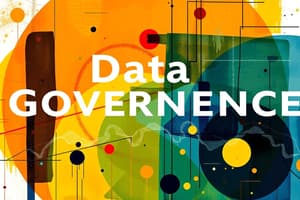Podcast
Questions and Answers
What is a key element of maximizing the use of structured data within an organization?
What is a key element of maximizing the use of structured data within an organization?
- Ignoring the data governance framework
- Limiting data collection to what is immediately useful
- Training staff to work without data guidelines
- Conducting a cost-benefit analysis for each data type (correct)
Which of the following best describes the importance of good quality data in supporting innovation?
Which of the following best describes the importance of good quality data in supporting innovation?
- It enables accurate decision-making and risk management. (correct)
- It is unrelated to any financial values generated.
- It allows for the creation of unreliable algorithms.
- It is mainly important for historical data analysis.
What are potential pitfalls of poor quality data?
What are potential pitfalls of poor quality data?
- Increased innovation and digitalization opportunities
- Improved collaboration among teams
- Higher customer satisfaction rates
- Misguided business strategies and decisions (correct)
In the context of data governance, who is responsible for ensuring data quality?
In the context of data governance, who is responsible for ensuring data quality?
How can organizations mitigate the risks associated with data management?
How can organizations mitigate the risks associated with data management?
What is a crucial aspect of ensuring data consistency and quality in reporting?
What is a crucial aspect of ensuring data consistency and quality in reporting?
In the bakery analogy, what role does the oven represent in data management?
In the bakery analogy, what role does the oven represent in data management?
What is a primary benefit of data governance in an organization?
What is a primary benefit of data governance in an organization?
Which element is NOT essential for producing quality data outputs?
Which element is NOT essential for producing quality data outputs?
In the context of the bakery analogy for data governance, what is essential for ensuring consistency?
In the context of the bakery analogy for data governance, what is essential for ensuring consistency?
What is the function of model validation teams in data governance?
What is the function of model validation teams in data governance?
Why is understanding data processing considered beneficial?
Why is understanding data processing considered beneficial?
What must be ensured regarding calculations performed during data processing?
What must be ensured regarding calculations performed during data processing?
What role does recognizing data as an asset play in an organization?
What role does recognizing data as an asset play in an organization?
Which of these actions is central to maintaining the quality of data in reporting?
Which of these actions is central to maintaining the quality of data in reporting?
What can result from differences in technology infrastructure in data management?
What can result from differences in technology infrastructure in data management?
What is necessary to achieve trusted financial reporting according to the content?
What is necessary to achieve trusted financial reporting according to the content?
How does improved data governance influence decision-making in organizations?
How does improved data governance influence decision-making in organizations?
Why are clear data definitions important in data governance?
Why are clear data definitions important in data governance?
What is the purpose of common taxonomies and definitions in data governance?
What is the purpose of common taxonomies and definitions in data governance?
Which aspect is not a benefit of having data governance?
Which aspect is not a benefit of having data governance?
Who is directly responsible for the day-to-day implementation and monitoring of data standards?
Who is directly responsible for the day-to-day implementation and monitoring of data standards?
What role does the Internal Audit play in the data governance framework?
What role does the Internal Audit play in the data governance framework?
Which group is accountable for ensuring compliance with policies related to data governance?
Which group is accountable for ensuring compliance with policies related to data governance?
Which of the following is NOT a responsibility of the Business Management in the data quality governance framework?
Which of the following is NOT a responsibility of the Business Management in the data quality governance framework?
What aspect does the Data Management Office focus on within the governance framework?
What aspect does the Data Management Office focus on within the governance framework?
Which of the following statements is true regarding the three lines of defence model?
Which of the following statements is true regarding the three lines of defence model?
Which component is primarily involved in the remediation and preventive controls within data governance?
Which component is primarily involved in the remediation and preventive controls within data governance?
Which of the following best describes the role of Data Governance Officers?
Which of the following best describes the role of Data Governance Officers?
What is the primary capability that risk systems must have in times of stress or crisis?
What is the primary capability that risk systems must have in times of stress or crisis?
Which reporting aspect ensures that risk information is presented appropriately for its audience?
Which reporting aspect ensures that risk information is presented appropriately for its audience?
What is the purpose of integrated procedures for reporting data errors?
What is the purpose of integrated procedures for reporting data errors?
What is the importance of reporting the frequency of risk information?
What is the importance of reporting the frequency of risk information?
What should reports identify regarding risks according to best practices?
What should reports identify regarding risks according to best practices?
Why is it critical for reports to be distributed while maintaining confidentiality?
Why is it critical for reports to be distributed while maintaining confidentiality?
What is a key feature of adaptable risk systems?
What is a key feature of adaptable risk systems?
What is expected of risk reporting in terms of comprehensiveness?
What is expected of risk reporting in terms of comprehensiveness?
What is a key element of the Data Management Program?
What is a key element of the Data Management Program?
Which of the following best describes data architecture?
Which of the following best describes data architecture?
What does the Analytics Management component primarily focus on?
What does the Analytics Management component primarily focus on?
Which aspect is NOT a part of the Data Control Environment?
Which aspect is NOT a part of the Data Control Environment?
What is a key responsibility within the Data Management Program?
What is a key responsibility within the Data Management Program?
Which best describes the role of Business Architecture?
Which best describes the role of Business Architecture?
What is emphasized in the Data and Technology Architecture component?
What is emphasized in the Data and Technology Architecture component?
Which of the following is NOT typically included in the Data Management Program's funding model?
Which of the following is NOT typically included in the Data Management Program's funding model?
Flashcards
Data governance
Data governance
A framework for managing data quality, access, and usage within an organization.
Data quality
Data quality
The degree to which data is accurate, consistent, complete, and relevant for its intended use.
Data architecture
Data architecture
The structure and design of how data is stored and organized in an organization.
Generative AI
Generative AI
Signup and view all the flashcards
Data risk
Data risk
Signup and view all the flashcards
Data Governance Benefits
Data Governance Benefits
Signup and view all the flashcards
The Bakery Analogy
The Bakery Analogy
Signup and view all the flashcards
Data Definition and Quality
Data Definition and Quality
Signup and view all the flashcards
Data Standards and Processes
Data Standards and Processes
Signup and view all the flashcards
Policies and Processes for Consistency
Policies and Processes for Consistency
Signup and view all the flashcards
Business Process and Rules
Business Process and Rules
Signup and view all the flashcards
Clear Assumptions and Limitations
Clear Assumptions and Limitations
Signup and view all the flashcards
Data is an Asset
Data is an Asset
Signup and view all the flashcards
Risk Reporting Adaptability
Risk Reporting Adaptability
Signup and view all the flashcards
Automated Risk Reporting Checks
Automated Risk Reporting Checks
Signup and view all the flashcards
Data Error Reporting
Data Error Reporting
Signup and view all the flashcards
Risk Concentration Reporting
Risk Concentration Reporting
Signup and view all the flashcards
Clear and Useful Risk Reporting
Clear and Useful Risk Reporting
Signup and view all the flashcards
Risk Reporting Frequency
Risk Reporting Frequency
Signup and view all the flashcards
Confidentiality in Risk Reporting
Confidentiality in Risk Reporting
Signup and view all the flashcards
Remedial Actions in Risk Reporting
Remedial Actions in Risk Reporting
Signup and view all the flashcards
Bakery Analogy
Bakery Analogy
Signup and view all the flashcards
Monitoring Controls
Monitoring Controls
Signup and view all the flashcards
Why are Monitoring Controls Important?
Why are Monitoring Controls Important?
Signup and view all the flashcards
Technology Architecture
Technology Architecture
Signup and view all the flashcards
Data Consistency
Data Consistency
Signup and view all the flashcards
Importance of Data Quality
Importance of Data Quality
Signup and view all the flashcards
Data Governance Program
Data Governance Program
Signup and view all the flashcards
Data Management Structure
Data Management Structure
Signup and view all the flashcards
Data Operations and Technology
Data Operations and Technology
Signup and view all the flashcards
Cross-control Alignment
Cross-control Alignment
Signup and view all the flashcards
Analytics Management
Analytics Management
Signup and view all the flashcards
Business Value from Analytics
Business Value from Analytics
Signup and view all the flashcards
Data Control Environment
Data Control Environment
Signup and view all the flashcards
Three Lines of Defence
Three Lines of Defence
Signup and view all the flashcards
Line 1: Business Management
Line 1: Business Management
Signup and view all the flashcards
Line 2: Governance & Oversight
Line 2: Governance & Oversight
Signup and view all the flashcards
Line 3: Independent Validation
Line 3: Independent Validation
Signup and view all the flashcards
Who are responsible for data quality?
Who are responsible for data quality?
Signup and view all the flashcards
Role of Group Data Management Office
Role of Group Data Management Office
Signup and view all the flashcards
What are the key elements of a data governance program?
What are the key elements of a data governance program?
Signup and view all the flashcards
How does Internal Audit contribute to data governance?
How does Internal Audit contribute to data governance?
Signup and view all the flashcards
Study Notes
Course Information
- Course title: Data Governance and Quality (ACCT673)
- University: Singapore Management University (SMU)
- Instructor: Irene Liu
- Contact information: +65 98 73 2234, [email protected]
- Program: SMU Accounting Masters Program
Course Structure
- Class Participation (15%): Attendance and active participation in class discussions and quizzes.
- Individual Assessments (45%): 2 short essay assignments (20%), 5 multiple-choice quizzes (25%).
- Group Projects (40%): Continuous assessments throughout the term, including class participation, progress assessments (case discussions, presentations, individual assignments, quizzes, mid-term exam), and group projects culminating in a final project. No final exam.
Lecture Series
- Business aspects of data management: Overview, strategy, and organization of data management practices
- Data governance: Definition, content, and data management documentation
- Data quality: Two parts focusing on quality components
- Data architecture & trends: Architecture, technology, and emerging trends in data management
- Recap: Review of key concepts
Lecture Schedule (Tentative)
- Overview: November 25
- Strategy: November 28
- Data organization: November 30
- Data governance: December 2
- Data documentation: December 5
- Data quality (1): December 7
- Data quality (2): December 9
- Data architecture: December 12
- Emerging trends: December 14
- Group presentation: December 16
Project Work
- Structure: Groups of 4-5 students with individual reflections.
- Questions: Two main questions regarding maximizing structured data use within an organization, and the role of good data quality in innovation (e.g., Generative AI). Questions include analysis of industry, geography, data collected, data risk mitigation, cost-benefit analysis, roles/responsibilities and data quality issues.
Introduction to Data Governance, and Data Quality
- Introduction to Data: Data is the new currency of the universe
- Key Problem: Regulatory pressure
- Citigroup case study: Regulatory issues with risk management systems
Data Governance and Quality - Miracle Pill
- Benefits of data governance: Improve data quality, reduce reputation risk & regulatory fines, streamline data processing, increase data usability, and enhance insights and decision-making.
- Recognising data as an asset (Important)
- Discussion: Benefits of data governance are presented in a "miracle pill" metaphor, highlighting the benefits that data governance and quality brings to any organization.
Additional Topics
- Bakery Analogy: Illustrates key components like good quality ingredients, standardized processes and policies, and a structured and controlled environment.
- Data Governance vs. Data Management: The difference between the concepts of data management and governance.
- DAMA-BOK & EDM Council's DCAM: Data management concepts from the DAMA standards, and frameworks relating to the Data Management disciplines involved.
- Data Management Capability Assessment Model: Steps to assess capability in data management and the process for achieving a capable state of data governance
- Regulatory Perspectives: Including BCBS 239 principles, emphasizing the importance of governance, architecture, accuracy, completeness, timeliness, adaptability, and reporting.
- Class Discussions: Focused on practical applications, insights and perspectives concerning data governance.
Studying That Suits You
Use AI to generate personalized quizzes and flashcards to suit your learning preferences.




